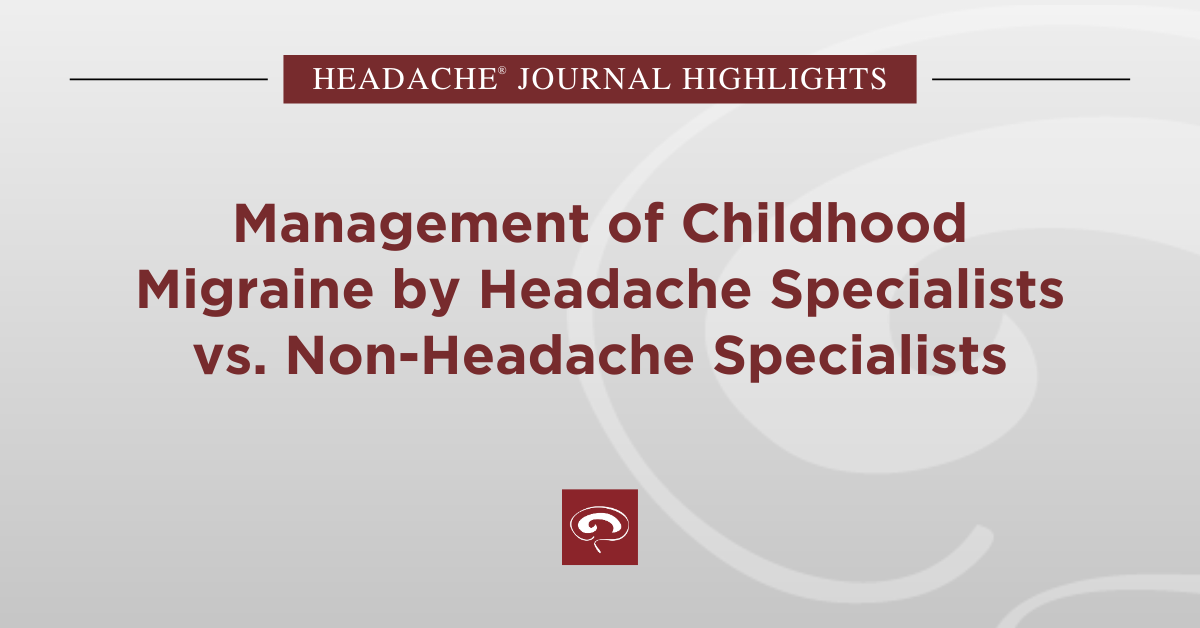
Headache Specialists vs. Non-Headache Specialists for Pediatric Treatments: A Review
Lauren Doyle Strauss, DO, FAHS, evaluates a study published in Headache® that looks at the differences in pediatric migraine management between different types of physicians
Management practices for children with migraine vary between headache specialists and non-headache specialists. But these differences need to be overcome in order to better serve headache patients.
This is according to an article published in Headache®. Radhika Gutta, BS, and colleagues examined the use of appropriate rescue medications and prophylactic agents, as well as the application of neuroimaging and short-term outcomes in children with migraine.
Lauren Doyle Strauss, DO, FAHS, commented on this study for the American Headache Society. Dr. Strauss says she was excited about reading this article because of what it shows about the difference in how specialists and non-specialists are perceived.
“What this study showed is that there is just so much need in headache treatment,” she says. “We can empower both primary care and neurology professionals to prescribe more.”
Differences in Triptan, Supplement Prescriptions
Dr. Gutta and colleagues studied the electronic medical records of children between the ages of 3-18 who had migraine and were evaluated at a tertiary care children’s hospital between 2016 and 2018. Headache specialists used triptans for migraine management in 56.7% of cases, compared with non-headache specialists, who prescribed them in only 28.7% of cases. Non-headache specialists prescribed prophylaxis in the form of natural supplements more frequently to children with chronic migraine compared to the headache specialist. Prophylaxis with prescription drugs was utilized more often by headache specialists (66.7%) than non-headache specialists (37.4%).
Analysis
Dr. Strauss says the difference in triptan prescriptions between specialists and non-specialists was not surprising. What was noteworthy, however, was how long it took for patients to receive a referral to a specialist. In light of this, Dr. Strauss notes that primary care doctors can do more for their headache patients prior to a referral.
“Diagnosis is number one,” she says. “Once you have the right diagnosis, the second step is identifying what we would all consider appropriate treatments in the younger age groups.”
Compared to adult migraine patients, Dr. Strauss says, doctors are more likely to rely on NSAID or over-the-counter medication options or supplements for daily prevention options for pediatric patients. Then, they move on to prescription medicines such as triptans or other daily preventative medications.
Cutting Down on Unnecessary Imaging
Another insight from the study was that imaging appeared to be commonly recommended by both headache specialists and non-headache specialists in children with migraine. Dr. Strauss believes that if a headache meets the classification for migraine and the neurologic exam is reassuring, then the next best step is to start or increase treatment with a daily preventative medication or to initiate triptans. There’s no sense in doing an imaging test when you could be starting treatment right away and potentially improving a patient’s headaches.
“If it sounds like migraine, it’s best to move forward with treatment because if the treatment helps and the headaches get better, then you don’t need to do more evaluations,” Dr. Strauss says. If more primary care doctors had felt empowered to diagnose migraine, “some of these children may not have gone on to neurology or to get an MRI.”
Conclusions and Implications for the Future
Dr. Strauss says one of the takeaways of the paper is that primary care doctors and neurologists should feel less hesitant to prescribe triptans to pediatric patients, especially now that there are calcitonin gene-related peptide (CGRP) medications and other new treatments in development.
“I would like to see more comfort prescribing some of the medications that we have experience with, so that the neurologists are going to be the providers who focus on the next escalation,” she says.
Dr. Strauss also points out that there needs to be further pediatric migraine research in multiple different topics. She highlights that there has only been one large randomized control trial that was multi-center: the CHAMP trial led by the Cincinnati Children’s Headache Program. Dr. Strauss says there needs to be more studies similar to what has been evaluated in adult patients.
Dr. Strauss says headache education for family practitioners and pediatricians, delivered through national conferences, would also be helpful.
“I think there’s so much we can do to empower pediatricians and family practice providers in identifying migraine, recognizing migraine, recognize when it’s not migraine, and understanding how helpful triptan use can be,” she says.
For more of the latest in headache research, please visit the AHS News page.


